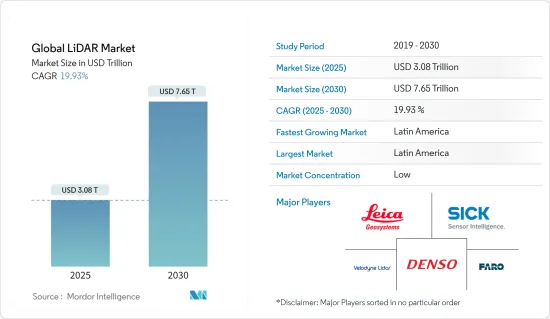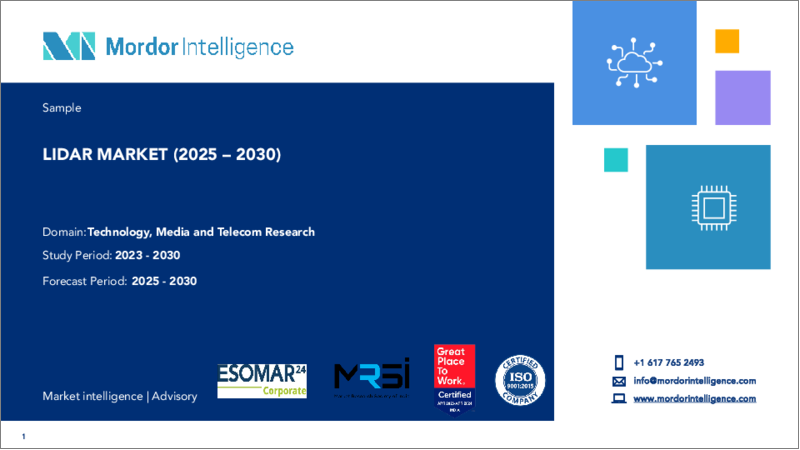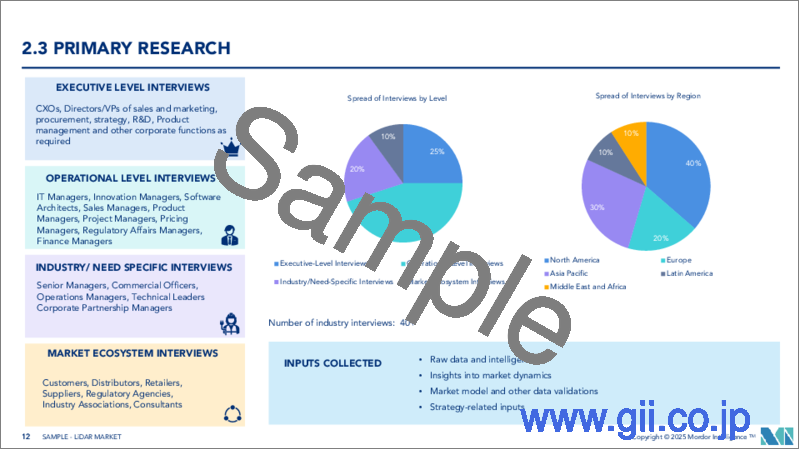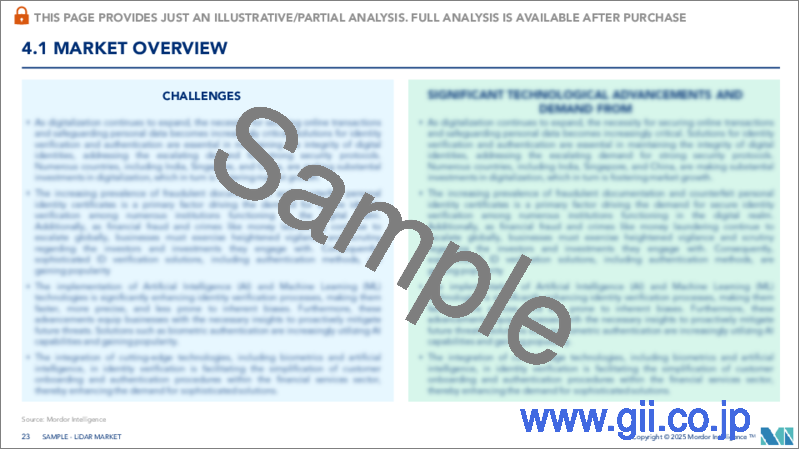|
|
市場調査レポート
商品コード
1637731
LiDAR:世界の市場シェア分析、産業動向・統計、成長予測(2025年~2030年)Global LiDAR - Market Share Analysis, Industry Trends & Statistics, Growth Forecasts (2025 - 2030) |
||||||
カスタマイズ可能
適宜更新あり
|
|||||||
| LiDAR:世界の市場シェア分析、産業動向・統計、成長予測(2025年~2030年) |
|
出版日: 2025年01月05日
発行: Mordor Intelligence
ページ情報: 英文 120 Pages
納期: 2~3営業日
|
全表示
- 概要
- 目次
世界のLiDARの市場規模は2025年に3兆800億米ドルと推計され、予測期間(2025-2030年)のCAGRは19.93%で、2030年には7兆6,500億米ドルに達すると予測されています。

LiDAR市場の成長を増大させる主な要因の1つは、UAVにおけるLiDARシステムの使用の増加、エンジニアリングおよび建設アプリケーションにおけるLiDARの使用、地理情報システム(GIS)アプリケーションにおけるLiDARの使用、4D LiDARの出現、さまざまなアプリケーションにおける商用ドローンの使用を取り巻く規制の緩和です。市場拡大の足かせとなっているのは、UAVや自律走行車をめぐる安全性への懸念と、手頃な価格で軽量な写真測量機器へのアクセスです。
主なハイライト
- 世界的に、特に開発途上国では、人口の増加に対応するため、エンジニアリングや土木建設活動の規模や範囲が大幅に拡大しています。測量やマッピングからプロジェクトのフィージビリティ・スタディの実施に至るまで、建築活動のあらゆる段階で、ますます多くの技術が必要とされています。LiDAR技術は、広大な地域の詳細な調査を簡単かつ正確に行うことができます。さらに、全地球測位システム支援レーザースキャナーと非常に高感度なカメラは、エンジニアがプロジェクト基準を満たす設計や正確な実現可能性評価を行う際に役立ちます。この結果、多くのLiDARサービス・プロバイダーが進出しています。
- 石油・ガスや鉱業の分野では、LiDAR技術により、科学者やマッピングの専門家は、これまで以上に高い精度、正確さ、柔軟性をもって、幅広いスケールで建築物や自然環境を調査することができます。自動化における政府からの奨励や、洪水救援や管理のような様々な政府部門の活動におけるLiDARの採用も、業界の成長を後押ししています。インドでは、運輸省が新しい高速道路を建設する前の測量にLiDARシステムの使用を義務付けています。
- ドローン、または無人航空機(UAV)は、その低コストと膨大なアプリケーションにより、多くの産業で採用が拡大しています。LiDARドローンは、大気組成、クラウド、地球構造、エアロゾルの研究のための機器として最初に開発されました。現在も世界中で気候観測の強力なツールとなっています。このデータを収集し、NOAAやその他の研究機関は、気候変動の理解を深めるためにこれらの機器を運用しています。
- 自動車分野における技術開発の開拓は、LiDAR市場の主要な促進要因です。企業は様々な技術の融合を模索しており、LiDAR技術が重要な役割を果たすかもしれないです。
- この技術の展開に関連する高コストは、この市場の成長を抑制しています。LiDARシステムは、今後数年間で配備が予想される自律型ドローンや自動車に標準装備されるようになると予想されます。自律走行車技術における急速な技術革新と政府からの支援の増加により、予測期間終了までにはレベル5自律走行車の早期配備が予想されます。業界が完全な自律走行車へと移行するにつれ、LiDARシステムへの依存度が高まっています。
- COVID-19の発生は世界中の産業に影響を与えました。自動車産業はLiDARの重要な採用企業の一つです。この発生により、様々な生産工場が操業停止となり、需要に影響を与えています。半導体材料の不足がさらに状況を悪化させています。
LiDAR市場動向
ロボット車両が市場を牽引する要因の一つ
- この分野では、ロボットカー、無人搬送車(AGV)、無人搬送車、ドローンにLiDAR技術を使用することが検討されています。ADAS(先進運転支援システム)は、Advanced Driver Assist System(先進運転支援システム)の頭文字をとったもの。LiDARは現在、自動運転車や自律走行車の開発に使用されている最先端技術のひとつです。LiDAR(Light Detection And Ranging)は、自律走行するドローン、ロボット、車両がナビゲーション、障害物検知、衝突回避のために使用することができます。
- LiDARによって、自動運転車、無人搬送車、その他のドローンは、人為的なミスのない正確な判断が可能になり、衝突の影響を受けにくくなります。これは、技術の進歩とLiDARセンサーの相対的なコスト削減により、近年増加しています。自動運転車は、LiDARのおかげで世界を360度見渡すことができます。また、高精度の深度情報を得ることもできます。
- AGVに搭載されたLiDARセンサーは、物体と車両間の距離を測定する一連のレーザーパルスを送信します。このコンパイルされたデータにより、作業エリアの360°環境マップが作成されます。このマッピングにより、AGVはインフラを追加することなく施設をナビゲートすることができます。
- ロボット車両にLiDARを使用するには、複数のLiDARを使用して車両の周囲をマッピングする必要があります。LiDARの使用は、搭乗者の安全を確保するために、高レベルのセンサーの冗長性が要求されます。乗客のための完全自律走行車やロボット車両の適切な開発はまだこれからであり、LiDARはこれらにおいても重要な役割を果たすと期待されています。
- ロボットナビゲーション用のLiDARは、環境や物体上の車両の位置に関する重要な距離測定情報を提供します。急速に拡大するeコマースと職場の安全性重視の高まりが、自律移動ロボット(AMR)と無人搬送車(AGV)市場の大きな成長を促しています。このような要因が、ロボット車両におけるLiDARアプリケーションの需要を押し上げると思われます。
- 例えば、スマートLiDARセンサーシステムのプロバイダーであるRoboSenseは、2022年11月に新製品RS-LiDAR-E1(E1)を発表しました。RS-LiDAR-E1は、自社開発のカスタムチップとフラッシュ技術プラットフォームに基づいて360°を見るフラッシュソリッドステートLiDARです。E1は、パートナーがスマートな運転知覚のギャップを埋め、自律運転の中核機能を実現するための重要なピースとして、自動運転車や自律走行車の全シナリオの知覚能力を向上させるのに役立ちます。
- さらに、屋外で活動する移動ロボットは、GPSのようなジオロケーション機能だけでなく、Lidarのようなセンシング技術にも依存して、現在地と目的地を特定することができます。LiDARセンサーは、ナビゲーションまたは障害物回避センサーに分類されます。ロボット・ビークルは、幅広い用途があるため、eコマースの売上が増加するにつれて需要が増加すると予想されます。ロボット車両用LiDARの市場は、eコマースの売上増加によって活性化すると思われます。
- 例えば、ベロダイン・ライダー社は2022年6月、ボストン・ダイナミクス社が複数年契約の一環として同社のライダーセンサーをロボットに使用すると発表しました。同社によると、同社のライダーセンサーは、気温の変化や暴風雨など、さまざまな条件下で移動ロボット(AMR)が自律的に動作することを可能にします。ロボットはセンサーを使用して、ローカライゼーション、マッピング、物体分類、物体追跡のためのリアルタイムの3D知覚データを得ることができます。
ラテンアメリカが大きな市場シェアを占める見込み
- ラテンアメリカは森林が密生しており、新興経済諸国として認識され、大きな拡大・発掘の機会を示しています。この地域の原生的な性質とLiDAR技術が相まって、この地域は調査された市場で堅実な成長を示すことが期待されています。
- 国連食糧農業機関(FAO)によると、ラテンアメリカとカリブ海地域の総面積の49%は森林に覆われています。同地域の森林面積は8億9,100万ヘクタールで、世界の森林面積の約22%を占める。この地域には世界の原生林の57%があり、生物多様性の保全に不可欠な地域です。
- さらに、FAOによると、森林面積の14%が生産的な森林として位置づけられています。この地域の重要な森林資源は、ライダー技術を林業に採用するための広い展望を生み出しています。LiDARを搭載したドローンをこれらの森林地域上空で使用し、人間活動の影響を示す3Dモデルを作成することができます。さらに、LiDARは樹木の覆いを貫通する能力があるため、この地域の厚い森林に覆われた地域では非常に有用です。
- 林業への技術応用に加え、この地域は農地にも恵まれています。FAOは、ラテンアメリカ・カリブ海地域を世界の食料安全保障の柱と位置づけ、2050年までに100億人を養うために必要な農業食料システムの変革を推進することを使命としています。このような野心的な目標は、地域の農産物輸出の増加と相まって、この分野での技術採用を後押しすると期待されています。
LiDAR産業の概要
LiDAR市場は、多くの大小プレーヤーが市場競争を繰り広げているため断片化しています。製品や技術の発表、戦略的パートナーシップ、買収、事業拡大、コラボレーションを通じて、これらのプレーヤーは市場での競争力を得ようとしています。市場の主要企業は、Sick AG、Teledyne Optech、Quanergy Systems Inc、Velodyne LiDAR、3D Laser Mapping Ltd、Denso Corporationなどです。
- 2024年2月-John Deere社は、ヘキサゴン傘下のLeica Geosystems社との戦略的パートナーシップを発表し、重建設業界のデジタルトランスフォーメーションの加速を支援します。ジョンディアとライカジオシステムズの協業は、両社の強みを生かし、世界中の建設専門家に新しい技術とサービスを提供します。
- 2023年5月-SICK AGは、4万個以上のSICKセンサーから得られる標準化された情報をAsset Administration Shells(AAS)という形で消費者やパートナーに提供すると発表。SICKは、産業のデジタル化の進展に大きく貢献する意欲を示しました。
その他の特典:
- エクセル形式の市場予測(ME)シート
- 3ヶ月間のアナリストサポート
目次
第1章 イントロダクション
- 調査の前提条件と市場定義
- 調査範囲
第2章 調査手法
第3章 エグゼクティブサマリー
第4章 市場洞察
- 市場概要
- 業界の魅力度-ポーターのファイブフォース分析
- 新規参入業者の脅威
- 買い手の交渉力
- 供給企業の交渉力
- 代替品の脅威
- 競争企業間の敵対関係
- 市場促進要因
- ドローンの急速な開発と用途拡大
- 自動車産業における採用の増加
- 市場の課題
- LiDARシステムの高コスト
- 業界のバリューチェーン
- 技術スナップショット
- 測定プロセスオプション
- レーザーオプション
- ビームステアリングオプション
- 光検出器オプション
- COVID-19の市場への影響
第5章 市場セグメンテーション
- 用途別
- ロボット車両
- ADAS
- 環境
- 地形
- 風
- 農業と林業
- 工業
- タイプ別
- 航空(地形・水深)
- 地上型(移動・静止)
- 地域別
- 北米
- 欧州
- アジア太平洋
- ラテンアメリカ
- 中東・アフリカ
第6章 競合情勢
- 企業プロファイル
- Leica Geosystems AG(Hexagon AB)
- Sick AG
- Trimble Inc.
- Quanergy Systems Inc.
- Faro Technologies Inc.
- Teledyne Optech
- Velodyne LiDAR Inc.
- Topcon Corp.
- RIEGL Laser Measurement Systems GmbH
- Leosphere(Vaisala)
- Waymo
- RoboSense LiDAR
- Denso Corporation
- Innoviz Technologies Ltd
- Neptec Technologies Corp.(Maxar)
第7章 市場展望
The Global LiDAR Market size is estimated at USD 3.08 trillion in 2025, and is expected to reach USD 7.65 trillion by 2030, at a CAGR of 19.93% during the forecast period (2025-2030).

One of the primary factors augmenting the LiDAR market growth is the increasing use of LiDAR systems in UAVs, the use of LiDAR in engineering and construction applications, the use of LiDAR in geographical information systems (GIS) applications, the emergence of 4D LiDAR, and the loosening of regulations surrounding the use of commercial drones in various applications. The market's expansion is being held back by safety concerns around UAVs and autonomous vehicles, as well as the accessibility of affordable and lightweight photogrammetry devices.
Key Highlights
- Globally, and especially in developing nations, the size and scope of engineering and civil construction activities have greatly increased to accommodate the growing population. All stages of building activities, from surveying and mapping to conducting project feasibility studies, call for an increasing amount of technology. LiDAR technologies can easily and accurately give a detailed survey of vast areas. Additionally, global positioning system-assisted laser scanners and extremely sensitive cameras assist engineers in creating designs that meet project criteria and accurate feasibility assessments. Many LiDAR service providers have expanded as a result of this.
- In the oil and gas and mining sector, LiDAR technology allows scientists and mapping professionals to examine built and natural environments across a wide range of scales with greater accuracy, precision, and flexibility than ever before. The encouragement from the government in automation and the adoption of LiDAR in various government sector activities, like flood relief and management, are also driving the industry's growth. In India, the Transport Ministry mandated the use of LiDAR systems in surveying areas before constructing a new highway.
- Drones, or unmanned aerial vehicles (UAV's), are witnessing growing adoption across many industries, owing to their low cost and vast array of applications. LiDAR drones were first developed as an instrument for studies on atmospheric composition, clouds, earth structures, and aerosols. They remain a powerful tool for climate observations around the world. Collecting this data, NOAA and other such research organizations operate these instruments to enhance understanding of climate change.
- The growing technological developments in the automotive sector is the major driving factor of the LiDAR market. The companies are looking for an amalgamation of various technologies, and LiDAR technology might play a vital role.
- High costs associated with the deployment of this technology are restraining the growth of this market. LiDAR systems are expected to become standard installations in autonomous drones and cars, expected to be deployed over the coming years. With fast-moving innovations in autonomous vehicle technologies and increasing support from the government, the early deployment of Level 5 autonomous vehicles is expected by the end of the forecast period. With the industry moving toward the complete autonomous range of vehicles, the dependence on LiDAR systems is growing.
- The COVID-19 outbreak affected industries around the world. The automotive industry is one of the significant adopters of LiDAR. The outbreak has resulted in the shutdown of various production plants impacting the demand. Semiconductor materials scarcity has further aggravated the situation.
LiDAR Market Trends
Robotic Vehicles are among the Factors Driving the Market
- This segment is considering using LiDAR technology in robotic cars, automotive guided vehicles (AGVs), uncrewed vehicles, and drones. ADAS (Advanced Driver Assist System) is an acronym for Advanced Driver Assist System. LiDAR is one of the most advanced technologies currently being used to develop self-driving cars and autonomous vehicles. LiDAR (Light Detection And Ranging) can be used by autonomous drones, robots, and vehicles for navigation, obstacle detection, and collision avoidance.
- LiDAR enables self-driving vehicles, AGVs, and other drones to make precise judgments without human error, making them less susceptible to crashes. This has increased in recent years due to technological advancements and the relative cost reduction of LiDAR sensors. A self-driving car can see the world with a continuous 360-degree view thanks to LiDAR. It also allows for highly accurate depth information.
- When mounted on an AGV, a LiDAR sensor sends out a series of laser pulses that measure the distance between objects and the vehicle. This compiled data creates a full 360° environmental map of the operational area. The resulting mapping allows the AGV to navigate the facility without additional infrastructure.
- Using LiDAR in robotic vehicles entails using multiple LiDARs to map the vehicle's surroundings. The use of LiDAR is required for a high level of sensor redundancy to ensure the safety of its passengers. The proper development of fully autonomous or robotic vehicles for passengers is still in the works, and LiDAR is expected to play a significant role in these as well.
- LiDAR for robotic navigation provides critical distance measurement information about the environment and the vehicle's position on objects. Rapidly expanding e-commerce and a greater emphasis on workplace safety are driving massive growth in the Autonomous Mobile Robot (AMR) and Automatic Guided Vehicle (AGV) markets. Such factors will drive up demand for LiDAR applications in robotic vehicles.
- For example, RoboSense, a Smart LiDAR Sensor Systems provider, held a new product launch in November 2022, RS-LiDAR-E1 (E1), a flash solid-state LiDAR that sees 360° based on its in-house, custom-developed chips, and flash technology platform. E1 will help partners bridge the gap in smart driving perception and improve the all-scenario perception capability of automated and autonomous vehicles as a critical piece to realizing the core functions of autonomous driving.
- Furthermore, mobile robots operating outside can rely on geolocation capabilities such as GPS, as well as sensing technologies such as Lidar, to determine where they are and where they are going. LiDAR sensors are classified as navigation or obstacle avoidance sensors. The demand for Robot vehicles is expected to increase as E-commerce sales increase due to their wide range of applications. The market for LiDARs for robotic vehicle applications will be fueled by an increase in E-commerce sales.
- For instance, Velodyne Lidar Inc. announced in June 2022 that Boston Dynamics would use its lidar sensors in its robots as part of a multi-year agreement. According to the company, its Lidar sensors enable mobile robots (AMR) to operate autonomously in a variety of conditions, including changing temperatures and rainstorms. Robots can use their sensors to obtain real-time 3D perception data for localization, mapping, object classification, and object tracking.
Latin America is Expected to Hold Significant Market Share
- Latin America has dense forest cover and can be identified as a developing economy, indicating significant expansion and excavation opportunities. Owing to the native nature of the region, coupled with LiDAR technology, the region is expected to witness solid growth in the studied market.
- According to the Food and Agriculture Organization (FAO) of the United Nations, 49% of the total area of Latin America and the Caribbean is covered by forests. The region's forest cover includes 891 million hectares, representing approximately 22% of the global forest area. The region is home to 57% of the world's primary forests, which makes it vital for biodiversity and conservation.
- Furthermore, according to FAO, 14% of the total forest area has been earmarked for productive functions. The region's significant forest resources create a wide-open prospect for the adoption of the Lidar technology for its adoption in forestry. LiDAR-equipped drones can be used over these forest areas to create 3D models that illustrate the impact of human activity. Furthermore, owing to the capacity of LiDAR to penetrate tree cover makes it exceptionally useful for the region's thick forest-covered area.
- In addition to the applications of technology in forestry, the region is marked for its farming lands. FAO has titled Latin America and the Caribbean as the pillar for world food security with a mission of driving the necessary agri-food systems transformation to feed 10 billion people by 2050. Such ambitious goals, coupled with increasing regional agricultural exports, are expected to support the adoption of the technology in the sector.
LiDAR Industry Overview
The LiDAR Market is fragmented due to many large and small players churning the competition in the market. Through product and technology launches, strategic partnerships, acquisitions, expansion, and collaboration, these players try to gain a competitive edge in the market. Key players in the market are Sick AG, Teledyne Optech, Quanergy Systems Inc., Velodyne LiDAR, 3D Laser Mapping Ltd, Denso Corporation, etc.
- February 2024 - John Deere announced a strategic partnership with Leica Geosystems, part of Hexagon, to assist in accelerating the digital transformation of the heavy construction industry. The collaboration between John Deere and Leica Geosystems would leverage the strengths of both companies to bring new technologies and services to construction professionals worldwide.
- May 2023 - SICK AG announced that it would provide standardized information from over 40,000 SICK sensors in the form of Asset Administration Shells (AAS) to consumers and partners. SICK demonstrated its aspiration to contribute significantly to the advancement of industrial digitalization.
Additional Benefits:
- The market estimate (ME) sheet in Excel format
- 3 months of analyst support
TABLE OF CONTENTS
1 INTRODUCTION
- 1.1 Study Assumptions and Market Definition
- 1.2 Scope of the Study
2 RESEARCH METHODOLOGY
3 EXECUTIVE SUMMARY
4 MARKET INSIGHTS
- 4.1 Market Overview
- 4.2 Industry Attractiveness - Porter's Five Forces Analysis
- 4.2.1 Threat of New Entrants
- 4.2.2 Bargaining Power of Buyers
- 4.2.3 Bargaining Power of Suppliers
- 4.2.4 Threat of Substitutes
- 4.2.5 Intensity of Competitive Rivalry
- 4.3 Market Drivers
- 4.3.1 Fast Paced Developments and Increasing Application of Drone
- 4.3.2 Increasing Adoption in the Automotive Industry
- 4.4 Market Challenges
- 4.4.1 High Cost of The LiDAR Systems
- 4.5 Industry Value Chain
- 4.6 Technology Snapshot
- 4.6.1 Measurement Process Options
- 4.6.2 Laser Options
- 4.6.3 Beam Steering Options
- 4.6.4 Photodetector Options
- 4.7 Impact of COVID-19 on the Market
5 MARKET SEGMENTATION
- 5.1 Application
- 5.1.1 Robotic Vehicles
- 5.1.2 ADAS
- 5.1.3 Environment
- 5.1.3.1 Topography
- 5.1.3.2 Wind
- 5.1.3.3 Agriculture and Forestry
- 5.1.4 Industrial
- 5.2 Type
- 5.2.1 Aerial (Topographic and Bathymetric)
- 5.2.2 Terrestrial (Mobile and Static)
- 5.3 Geography
- 5.3.1 North America
- 5.3.2 Europe
- 5.3.3 Asia Pacific
- 5.3.4 Latin America
- 5.3.5 Middle East and Africa
6 COMPETITIVE LANDSCAPE
- 6.1 Company Profiles
- 6.1.1 Leica Geosystems AG (Hexagon AB)
- 6.1.2 Sick AG
- 6.1.3 Trimble Inc.
- 6.1.4 Quanergy Systems Inc.
- 6.1.5 Faro Technologies Inc.
- 6.1.6 Teledyne Optech
- 6.1.7 Velodyne LiDAR Inc.
- 6.1.8 Topcon Corp.
- 6.1.9 RIEGL Laser Measurement Systems GmbH
- 6.1.10 Leosphere (Vaisala)
- 6.1.11 Waymo
- 6.1.12 RoboSense LiDAR
- 6.1.13 Denso Corporation
- 6.1.14 Innoviz Technologies Ltd
- 6.1.15 Neptec Technologies Corp. (Maxar)





